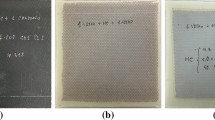Abstract
A quick and inexpensive method of nondestructive evaluation is described based on imagenhanced backlighting. The method is capable of being applied to translucent composite materials such as Kevlar/epoxy and glass/epoxy to detect delamination with high resolution. The use of an enhancing dye also makes the method suitable for monitoring surface cracking. The technique has also been demonstrated to be an especially convenient method of observingin situ the growth of cracking and delamination damage as a composite is loaded, and is capable of monitoring thedynamic growth of damage in impact-loading situations. It has been shown to be appropriate for detecting barely visible damage resulting from either impact or static loading on thick laminated structures that even include honeycomb reinforcement.
Similar content being viewed by others
References
R. M. Crane and J. Gagorik, Fiber optics for a damage assessment system for fiber-reinforced plastic composite structures, inReview of Progress in Quantitative NDE, (San Diego, California, August 1984), Vol. 28, pp. 1419–1430.
P. Cielo, X. Maldagne, A. Déom, and R. Lewak, Thermographic nondestructive evaluation of industrial materials and structures,Mater. Eval. 45, (6) 452–460 (1987).
N. Takeda, R. L. Sierakowski, and L. E. Malvern, Transverse cracks in glass/epoxy cross-ply laminates impacted by projectiles,J. Mater. Sci. 16; 2008–2011 (1981).
C. A. Ross, L. E. Malvern, R. L. Sierakowski, and N. Takeda, Finite Element Analysis of Interlaminar Shear Stress due to Local Impact,Recent Advances in Composites in the United States and Japan, ASTM STP 864, American Society for Testing Materials, 1985, pp. 355–367.
D. Liu, Impact-induced delamination—A view of bending stiffness mismatching,J. Comp. Mater. 22: 674–692 (1988).
G. Caprino, I. C. Visconti, and A. Di Ilio, Elastic behaviour of composite structures under low velocity impact,Composites 15 (3): 231–234 (1984).
G. A. Baxes,Digital Image Processing, (Prentice-Hall, Denver, 1984).
N. D. W. Glossop,An Embedded Fibre Optic Damage Detection Sensor for Impact Damage Detection in Composite Materials, Ph.D. thesis,UTIAS 332, University of Toronto, Institute for Aerospace Studies, 1989.
R. M. Measures, N. D. W. Glossop, J. Lymer, M. Leblanc, J. West, S. Dubois, W. Tsaw, and R. C. Tennyson, Structurally integrated fiber optic damage assessment system for composite materials,Appl. Opt. 28: 2626–2633, 1989.
N. D. W. Glossop, S. Dubios, W. Tsaw, M. Leblanc, J. Lymer, R. M. Measures, and R. C. Tennyson, Optical fiber damage detection for an aircraft composite leading edge,Composites, March 1990.
R. M. Measures, Fibre optic senses—The key to smart structures,SPIE 1120–1122 (1989).
R. M. Measures, Smart Structures with nerves of glass,Prog. Aerospace Sci. 26, 1989.
Author information
Authors and Affiliations
Rights and permissions
About this article
Cite this article
Glossop, N.D.W., Tsaw, W., Measures, R.M. et al. Image-enhanced backlighting: A new method of NDE for translucent composites. J Nondestruct Eval 8, 181–193 (1989). https://doi.org/10.1007/BF00570886
Received:
Revised:
Issue Date:
DOI: https://doi.org/10.1007/BF00570886




